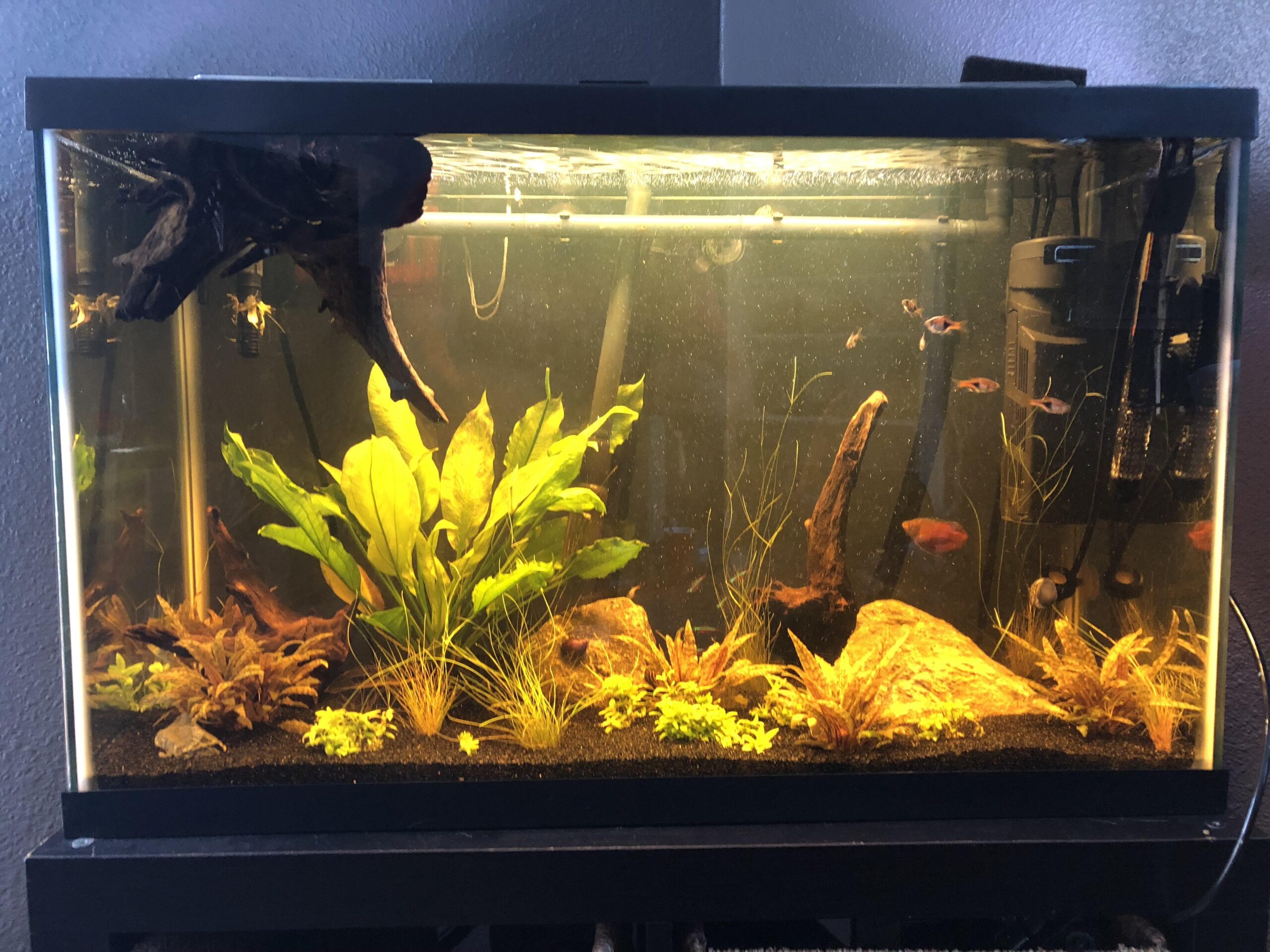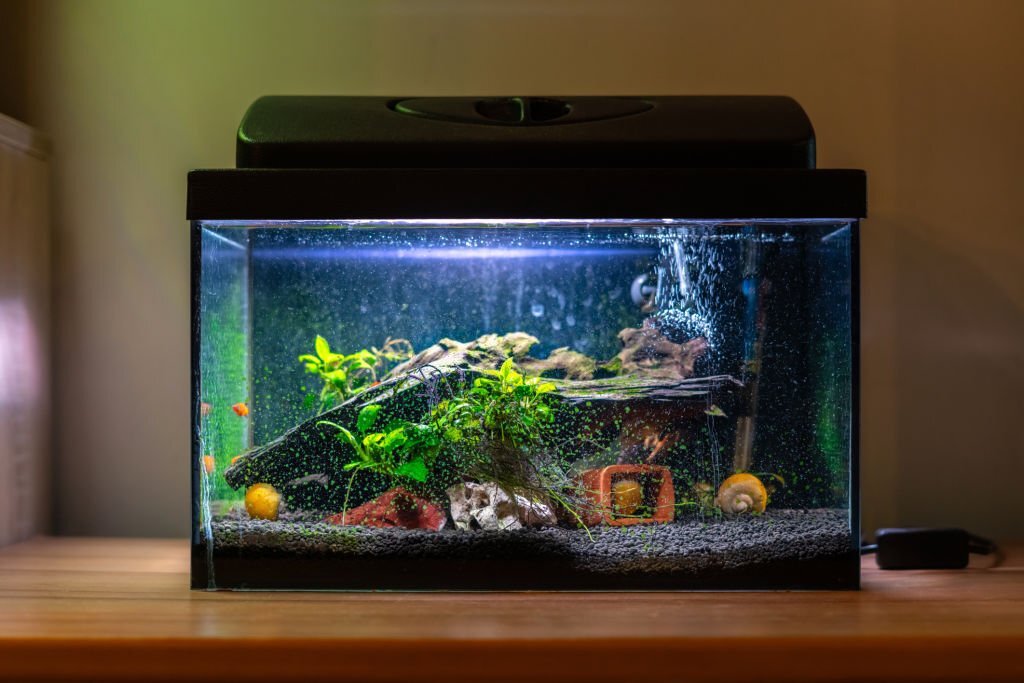Smartplantedaquarium.com participates in affiliate marketing programs. We may earn commissions on purchases made through our affiliate links. This doesn't affect our content or recommendations and we only recommend products we would put in our own tanks.
Are you tired of your aquarium water looking like a cup of tea? Aquarium enthusiasts, we understand your concern. Tannins from driftwood or leaves can give your tank an unsightly brownish tint. But worry not!
In this guide, we’ll share quick and effective methods to clear up your aquarium water, so your aquatic buddies can shine in crystal-clear surroundings. Say goodbye to tannin troubles and hello to a pristine aquarium!
Contents
Key Takeaways
- Tannins are naturally occurring organic compounds found in plants, wood, and some fruit.
- Tannins can give aquarium water a brownish tint, similar to tea.
- The primary sources of tannins in aquariums are driftwood, leaves, peat moss, cones, nut pods, plants, natural substrates, overfeed and decay, wood-based decorations, and intentional tannin extracts.
- Tannins can have both advantages and disadvantages in aquariums.
- Advantages include natural environment simulation, antifungal and antibacterial properties, enhanced breeding conditions, pH buffering, protective cover, toxin binding, enhanced colors, and support for plant growth.
- Disadvantages include water discoloration, alteration of pH levels, reduced light penetration, interference with medications, challenges in monitoring fish health, alteration of water parameters, aesthetic preferences, potential over-acidification, and maintenance challenges.
- To remove tannins from wood, choose aquarium-safe wood types, clean the wood, boil it, soak it in water, test it, and then place it in the aquarium.
- To remove tannins from aquarium water, perform regular water changes, use activated carbon, use poly filter pads, or use Purigen.
What Are Tannins
Tannins are naturally occurring organic compounds, commonly found in plants, wood, and some fruit. They belong to a class of chemicals known as polyphenols and have a distinctive astringent taste that can be recognized in foods such as tea, wine, and certain types of fruit like unripe apples.
In the context of aquariums, tannins are most often associated with driftwood and certain types of leaves that are added to fish tanks. When driftwood, leaves, or other organic materials begin to decompose in aquarium water, they release tannins. This can result in a discoloration of the water, giving it a tea-like hue.
Sources of Tannins in Aquariums
Tannins are organic compounds that can naturally seep into aquarium water from various sources. While they can impart a distinctive color to the water and alter its parameters, understanding these sources can help aquarists manage and control tannin levels effectively. Here are the primary sources of tannins in aquariums:
- Driftwood: Driftwood is a popular decorative choice in many aquariums due to its natural aesthetics. However, when submerged in water, it releases tannins, especially during the initial weeks or months. The type of wood and its age can influence the amount and rate of tannin release.
- Leaves: Certain types of dried leaves, like Indian almond leaves (also known as catappa leaves), are introduced into aquariums for their health benefits and natural appearance. These leaves release tannins as they decompose.
- Peat Moss: Peat moss, when used in aquarium filters or as a substrate, can release tannins. It’s often utilized in aquariums to soften water and lower pH.
- Cones: Pinecones and alder cones, when added to aquariums, can also release tannins. While they add to the natural decor, they can influence the water’s color and parameters.
- Nut Pods: Various nut pods and seed capsules are used in biotope aquariums to mimic natural habitats. These can release tannins over time.
- Aquatic Plants: While not as significant as other sources, certain aquatic plants can release minimal amounts of tannins, especially when they start decaying.
- Natural Substrates: Some natural substrates, especially those containing organic matter, might release tannins, albeit in smaller quantities compared to sources like driftwood or peat moss.
- Overfeed and Decay: Overfeeding fish can lead to uneaten food decaying at the bottom of the tank. This decomposition process can produce tannins, although this is a less common source.
- Wood-based Decorations: Besides driftwood, other wooden decorations or structures in the tank can also be a source of tannins.
- Tannin Extracts: Some aquarists might intentionally add tannin extracts to the water to mimic specific environments or for their beneficial properties.
Are Tannins Good or Bad in Aquariums
Tannins in aquariums have both advantages and disadvantages, and whether they are considered “good” or “bad” largely depends on the specific requirements of the tank’s inhabitants and the aesthetic preferences of the aquarist. Let’s delve into both sides of the argument:
Advantages of Tannins in Aquariums
- Natural Environment Simulation: Tannins can recreate a natural, blackwater environment for certain fish species, such as those from the Amazon River Basin or Southeast Asian blackwater habitats. The tinted water can make these species feel at home, potentially reducing stress and encouraging natural behaviors.
- Antifungal and Antibacterial Properties: Tannins are known to have mild antifungal and antibacterial characteristics. This can play a role in preventing certain diseases in the tank and generally bolstering the health of aquatic inhabitants.
- Enhanced Breeding Conditions: Some species of fish prefer tannin-rich waters when breeding. The tannins can stimulate breeding behaviors, provide a conducive environment for egg-laying, and even offer some protection for the eggs against fungal infections.
- pH Buffering: Tannins have the ability to mildly acidify aquarium water. For species that thrive in slightly acidic conditions, this natural buffering can help maintain a stable and preferred pH range.
- Protective Cover: The slight discoloration caused by tannins can act as a protective shade, shielding fish from excessive light. This can be especially beneficial in tanks with brighter lighting, providing fish with a sense of security and reducing stress.
- Toxin Binding: Tannins can bind to certain toxins and heavy metals present in the water, rendering them less harmful to the tank’s inhabitants.
- Enhanced Colors: The presence of tannins can enhance the colors of certain fish species. The darkened environment can make colors pop, especially in species with vibrant hues.
- Natural Aesthetics: For aquarists aiming to create a biotope aquarium that mimics a specific natural habitat, tannins provide an authentic look. The amber-tinted water replicates the conditions of certain natural ecosystems, adding to the overall aesthetics of the tank.
- Support for Plant Growth: While excessive tannins can limit light penetration, a mild presence can be beneficial for certain plants that naturally grow in blackwater environments. These plants are adapted to thrive in such conditions and can benefit from the presence of tannins.
Disadvantages of Tannins in Aquariums
- Water Discoloration: One of the most noticeable effects of tannins is the brownish or tea-colored tint they impart to the water. For aquarists who prefer crystal-clear water, this discoloration can be seen as a drawback, obscuring the view of the fish and plants.
- Alteration of pH Levels: Tannins can acidify the aquarium water, potentially lowering the pH. While this might be beneficial for certain species, it can be detrimental for fish and plants that prefer neutral or slightly alkaline conditions.
- Reduced Light Penetration: The tinted water resulting from tannins can reduce the amount of light reaching deeper sections of the tank. This can impact photosynthetic aquatic plants, especially in deeper or densely planted tanks, potentially hindering their growth.
- Interference with Medications: In tanks treated with certain medications, tannins can interfere with their efficacy. It’s important to be aware of this if you’re introducing medicines into a tannin-rich environment.
- Challenge in Monitoring Fish Health: The darker water can make it challenging to observe fish closely, potentially making it harder to detect early signs of disease or injury.
- Alteration of Water Parameters: Apart from pH, tannins can influence other water parameters, such as hardness. This can impact the well-being of species that have specific water parameter requirements.
- Aesthetic Preferences: While some aquarists appreciate the natural look that tannins offer, others might find it unattractive. The aesthetic appeal is subjective, but for those who desire a bright and clear tank, tannins can be seen as a disadvantage.
- Potential Over-acidification: If tannins are present in excessively high concentrations and are not monitored, they can lead to a significant drop in pH, creating overly acidic conditions. This can be harmful to many aquarium inhabitants, especially if the change is rapid.
- Maintenance Challenges: For aquarists aiming to maintain specific water parameters, the presence of tannins can add an additional layer of complexity, requiring more frequent water tests and adjustments.
How To Remove Tannins From Wood
Introducing wood to an aquarium can create a natural and aesthetically pleasing environment for its inhabitants. However, fresh wood can release tannins into the water, leading to discoloration and changes in pH. To prevent this, it’s essential to treat the wood beforehand. Here are step-by-step instructions on how to remove tannins from wood before placing it in your aquarium:
Selection of Suitable Wood: Begin by choosing aquarium-safe wood types like Mopani, Malaysian, or Bogwood. Avoid woods that have been treated with chemicals or are resinous, as they can be harmful to fish.
Cleaning the Wood: Brush the wood surface with a soft brush to remove dirt, dust, and any loose debris. Rinse thoroughly with clean water.
Boiling the Wood: If the piece of wood is small enough, place it in a large pot of water and bring it to a boil. Allow the wood to boil for at least 1-2 hours. This process will not only help in releasing tannins faster but also sterilize the wood, killing any potential pathogens. Change the water and repeat the boiling process if it becomes too discolored.
Soaking the Wood: For larger pieces that cannot be boiled, soak the wood in a large container filled with water. Change the water daily or when it becomes discolored. Continue this process for at least a week or until the water remains relatively clear. The duration might vary depending on the type and size of the wood.
Waterlogged Wood: Fresh wood tends to float. The boiling and soaking processes will saturate the wood, making it sink in the aquarium. If the wood still floats after treatment, it may need additional soaking or can be anchored down in the aquarium until it becomes waterlogged.
Testing the Wood: Before introducing the wood to the aquarium, place it in a separate container with clean water for a day. If the water remains clear and there’s no significant drop in pH, the wood is ready to be added to the aquarium.
Placement in the Aquarium: Once you’re confident that most tannins have been removed and the wood is safe, you can introduce it to the aquarium. Ensure it’s placed securely, so it doesn’t shift and harm the tank’s inhabitants.
How To Remove Tannins From Aquarium Water
Tannins can give aquarium water a yellowish-brown tint, reminiscent of tea. While this might be desirable for creating certain natural environments, many aquarists prefer clear water for aesthetic reasons and to ensure the well-being of specific fish species. Here’s a step-by-step guide on how to remove tannins from aquarium water:
Regular Water Changes: One of the simplest and most effective methods is to perform regular water changes. Replace 10-25% of the tank’s water with fresh, dechlorinated water weekly. This dilutes the concentration of tannins and helps maintain water clarity.
Activated Carbon: Activated carbon is a commonly used filter media that can efficiently remove tannins. Place activated carbon in a mesh bag and add it to your filter. Ensure you replace the carbon every few weeks as it can become saturated and lose its effectiveness.
Poly Filter Pads: Specialized filter pads, like poly filter pads, are designed to remove organic compounds, including tannins, from water. These can be placed in the filter and should be changed as per the manufacturer’s recommendations or when they become discolored.
Purigen: Purigen is a synthetic adsorbent that is more porous than activated carbon. It effectively removes tannins and other organic compounds. Place Purigen in your filter as per the manufacturer’s guidelines. One of its advantages is that it can be regenerated and reused multiple times.
Water Softening Pillows: These are resin-based products that can be placed in filters. They not only remove tannins but also soften the water by extracting certain minerals.
Reverse Osmosis (RO) and Deionization (DI): RO and DI units are advanced filtration systems that can purify water by removing a vast majority of its contaminants, including tannins. While they are highly effective, they can be an investment in terms of cost and maintenance.
Use Tannin-removing Products: Some commercial products are designed specifically to remove tannins from aquarium water. Always follow the manufacturer’s instructions when using these products.
Avoid Overstocking with Organic Materials: Minimize the addition of materials like driftwood and leaves that release tannins. If you’re keen on having wood in your aquarium, treat it (as previously described) before introducing it to the tank.
Monitor pH Levels: Since tannins can influence pH, regularly test the water’s pH levels. If you notice a consistent drop in pH, it might indicate high tannin concentrations.
Increase Filtration: Enhancing the overall filtration of your aquarium can help in faster removal of tannins. Consider adding a secondary filter or increasing the flow rate.
Conclusion
Removing tannins from aquarium water is a crucial task for maintaining a healthy and clear aquatic environment for your fish and other aquatic life. Tannins can negatively impact water quality, pH levels, and overall aesthetics.
To effectively address this issue, consider using one or a combination of methods mentioned earlier, such as activated carbon, water changes, or specialized tannin-removing products.
Regular maintenance and monitoring of water quality are essential to ensure your aquarium remains a suitable habitat for your aquatic pets. By following these steps, you can enjoy a pristine and thriving aquarium ecosystem.
Frequently Asked Questions
1. How long does it take for tannins to go away?
The time it takes for tannins to dissipate from aquarium water varies based on the source and concentration of the tannins, as well as the steps taken to remove or dilute them. If left untreated, tannins from sources like driftwood can persist for weeks to months. Regular water changes and the use of activated carbon or other filtration media can expedite their removal, often reducing the time to a few weeks or even days.
2. Does filter floss remove tannins?
Filter floss is primarily designed to capture and remove physical debris and particulate matter from the water. While it can help in improving water clarity, it’s not specifically designed to remove dissolved substances like tannins. For tannin removal, activated carbon or specialized resins are more effective.
3. Can tannins kill fish?
Tannins themselves are not toxic to fish. However, they can lower the pH of the water, making it more acidic. If the pH drops too quickly or to levels that are not suitable for the fish species in the tank, it can stress or harm the fish. Always monitor pH levels when tannins are introduced or if they are present in high concentrations.
4. Does carbon remove tannins from aquarium?
Yes, activated carbon is effective in removing tannins from aquarium water. When water passes through activated carbon in a filter, the carbon attracts and captures the tannin molecules, helping to clear the water. It’s essential to replace the carbon regularly, as it can become saturated and lose its effectiveness.
5. Do tannins reduce algae growth?
Indirectly, yes. Tannins can tint the water, reducing the amount of light that penetrates deeper into the tank. Reduced light levels can limit the growth of photosynthetic organisms, including algae. However, the presence of tannins alone is not a guaranteed method to control algae, and other factors like nutrient levels also play a significant role.
6. Do plants remove tannins?
Aquatic plants do not directly remove tannins from the water. However, plants can absorb certain nutrients and compounds that, if left unchecked, could contribute to tannin production, especially from decaying organic matter. While they play a role in maintaining overall water quality, for direct tannin removal, other methods like activated carbon filtration are more effective.



